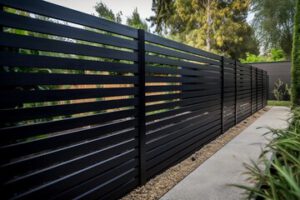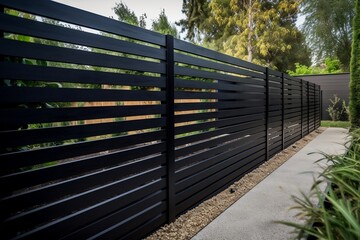A privacy fence restricts the line of sight of your backyard from neighboring homes. This protects valuable outdoor equipment like pools and hot tubs from nosy neighbors and keeps children, pets, and other trespassers out of the yard.
A privacy fence can also add a natural aesthetic to your property. Several different styles of custom privacy fences are available, each with its own benefits and drawbacks. Visit https://www.maiseyfence.com/ for more information.
Unlike traditional wood fences, which often become rotted or bowed over time, steel privacy fencing offers long-lasting durability. These fences feature 26-gauge steel framing and galvanized panels that are painted to match the house or landscape. They’re also rust-resistant, making them a great choice for coastal areas.
Mueller steel fences are available in a variety of panel colors and finishes to complement any home, and they’re designed for a sleek, modern look. The panels can be sheeted on both sides to provide even more privacy.
These fences are a smart option for homeowners who want to add security and beauty to their property without spending a lot of money. They’re made of welded and galvanized steel that’s powder-coated to resist rust. They’re also durable enough to resist damage caused by vehicles, snow, and high winds.
A metal privacy fence will cost more upfront than a wooden one but will last longer. This is because steel fence posts aren’t vulnerable to rot or mildew like wood ones are. The fence posts also have the added benefit of standing up straighter than their wooden counterparts, which tend to lose their shape over time.
The downside to metal fences is that they offer only limited security. While wrought iron and steel do a good job of keeping children and pets from wandering off your property, they don’t prevent prying eyes from seeing into your yard. Other metal fence types, such as chain-link and wire, are climbable or can be cut with a screwdriver, making them less effective at preventing trespassing.
Fortunately, many manufacturers now create metal fences that combine both strength and privacy. For example, some companies manufacture a type of fence that uses wooden posts and a corrugated metal infill. This design is still vulnerable to rot and damage from high winds, but it’s far stronger than a traditional wooden privacy fence.
Other manufacturers use a more aesthetically pleasing type of steel infill. This infill is shaped into vertical or horizontal slats to mimic the look of a wood fence, but they’re much more durable. They’re also easy to install, and some have laser-cut semi-transparent designs that boost aesthetics while adding privacy.
Aluminum
Aluminum is a highly durable material that looks great and can last for years with little to no maintenance. It is also easy to match with your home and landscaping, which makes it a popular choice for privacy fences. It is also available in a wide range of colors and styles, making it a versatile option for homeowners looking to add curb appeal to their home and yard.
Aluminum fences can be made with either solid panels or a more traditional style with spaces between the horizontal slats. The width of the gap will determine how private your fence is, so be sure to consider this before choosing an aluminum privacy fence. In addition to ensuring privacy, modern aluminum fences are extremely hard to break, which will protect your children and pets from unwanted intruders and deter criminals.
Another advantage of a privacy fence is that it will help to keep debris, leaves and other items from blowing into your yard. It will also provide shade for your patio or backyard depending on the height of the fence, which can be very helpful during the summer when temperatures are high.
Privacy fences can be used to hide unsightly areas of your property, such as garbage and recycling bins or outdoor machinery. They can also be used to block off a pool or hot tub area for safety and security purposes.
If you are considering a privacy fence, it is important to talk to your neighbors about it before you start construction. You don’t want them to be surprised or offended by the new look of your home. In addition, it is a good idea to make sure that they know how much you plan on spending on your fence so that they aren’t shocked when the invoice arrives.
A privacy fence will not only boost the appearance of your home, but it will also increase its value. It will help to keep intruders out, as well as animals and other undesirable pests. A strong, well-maintained fence will also dissuade thieves who are less likely to attempt a burglary when they know that the property is protected by a sturdy barrier.
Wood
Often used to accentuate a home’s landscape design and to keep children and pets safe outside, wood privacy fences offer several benefits. They’re a good choice for obscuring the view of neighbors’ homes and backyards from yours, making them ideal for people who like to relax in a peaceful setting without having to worry about nosy neighbors or passers by.
Wood is a traditional material for privacy fences and offers the flexibility of many styling options, including different finishes like paint or lacquers. It is also durable, though not as strong as materials such as concrete and metal. A local fencing contractor can provide advice on what will work best for your budget and property’s needs.
A wood privacy fence is a cost-effective option that can add value to your home, as well as increase its security and curb appeal. It is a natural and organic material that adds warmth to your landscaping and can be stained or painted to suit your tastes. It can also be carved and etched to create unique designs.
Depending on your location and municipal ordinances, you may need to obtain a permit for installing a wood privacy fence. However, unlike some other types of fences, a permit for a wood privacy fence is often not required if it is only six feet tall or less.
In addition to protecting your yard and garden from trespassers, a wood fence can serve as a protective enclosure for family vegetable gardens. It is ideal for keeping vegetables, fruit trees, and other edible plants away from hungry animals.
When it comes to the type of wood for your fence, it’s important to select a grade that’s rot-resistant. It’s also a good idea to use treated wood for added protection from the elements and insects. The most popular wood for privacy fences is western red cedar.
Another great option for enhancing the look of your privacy fence is to run lattice along the top. This doubles as a decorative element while increasing your fence’s height beyond the standard six feet if you need to.
Slatted Chain Link
Slatted chain link fences have horizontal slats woven into the vertical wires to make your yard feel private and secluded. They are available in a variety of colors and styles to match your outdoor decor. They are also easy to install and can be used in addition to a solid wood or vinyl fence for a more aesthetically pleasing look.
The slats are made of aluminum or high-density polyethylene, which is an extremely durable material that holds up to harsh weather and other elements. They are often coated with a UV-resistant paint to protect them from the sun’s rays and to keep them looking new. Adding color slats to a chain link fence also gives it a more finished appearance that can increase curb appeal.
Another benefit of installing a privacy slat fence is that it can prevent strangers from seeing into your yard. This can be especially helpful for homeowners who live near sidewalks or busy streets, or in a subdivision that doesn’t have a lot of privacy. A privacy slat fence is also an excellent choice for commercial properties that need to block out traffic noise and visual distraction.
There are several different types of slats to choose from, each with its own advantages and disadvantages. For example, top locking slats are flat tubular plastic inserts that lock into a flat polyethylene channel that is routed through the top diamonds of the chain link. They are easy to install, and offer about 75% privacy. Bottom lock slats are hollow, tubular HDPE extrusions that fit into the bottom channels of the chain link mesh and stay in place without needing to be locked or sealed into place. They are easier to install than top slats, but they don’t align as well at the top.
Wing slats are reinforced inserts that have additional, serrated plastic wings on the sides. They require less installation time, and lock into the chains’ knuckles with their own power. They are also able to handle a higher wind load than other types of slats and offer near full (90%) privacy.
